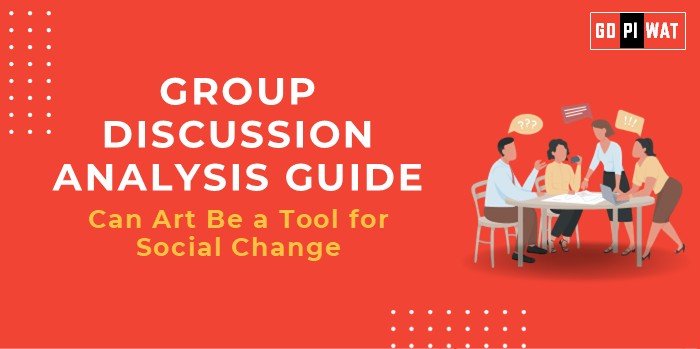📋 Group Discussion (GD) Analysis Guide: Can Art Be a Tool for Social Change
🌐 Introduction to the Topic
- 💡 Opening Context: Art has long been a mirror and molder of society, influencing perceptions and challenging norms globally and nationally.
- 📜 Background: From Picasso’s Guernica, which became a symbol against war, to India’s Dandi March mural, art has consistently proven its role as a catalyst for social transformation. In an era of heightened social awareness, the intersection of art and activism is increasingly relevant for B-school discussions.
📊 Quick Facts and Key Statistics
- 📈 Creative Economy Contribution: Generates 3% of global GDP, showcasing its economic and cultural impact.
- 🌍 UNESCO Data: 67% of cultural expressions focus on social themes like inequality and climate change.
- 🎨 Public Art Influence: Over 70% of urban respondents in a recent survey linked public art to heightened community engagement.
- 🧵 Indian Handicraft Sector: Employs 7 million artisans, bridging heritage and socio-economic change.
👥 Stakeholders and Their Roles
- 🎨 Artists: Create impactful messages and foster emotional connections.
- 🏛️ Government and NGOs: Fund and promote socially conscious art projects.
- 🏢 Corporate Sector: Incorporate art in CSR initiatives to drive social narratives.
- 🌐 Communities: Engage with art as participants and changemakers.
🏆 Achievements and Challenges
✨ Achievements
- 🌱 Public murals addressing climate change, e.g., Delhi’s air pollution art installations.
- 🎥 Bollywood films like Pad Man promoting menstrual hygiene awareness.
- 🎨 Street art in Brazil’s favelas reducing crime rates by 20%.
⚠️ Challenges
- 💸 Funding limitations, with global art funding receiving less than 2% of development aid.
- 📶 Accessibility disparities in rural and marginalized communities.
- 🛑 Censorship and political interference stifling artistic expression.
🌍 Global Comparisons
- 🇳🇴 Success: Norway’s investment in public art to drive social awareness campaigns.
- 🇨🇳 Challenge: Chinese censorship restricting socio-political art forms.
📚 Case Studies
- 🎭 Kochi-Muziris Biennale: Highlights social issues through contemporary art.
- 🎨 Banksy’s graffiti art: Provokes thought on inequality and capitalism.
💬 Structured Arguments for Discussion
- 💪 Supporting Stance: “Art transcends barriers to become a universal language of change, as seen in its role in global movements like Black Lives Matter.”
- ⚖️ Opposing Stance: “Art’s impact is limited without systemic change, making it an accessory rather than a driver of reform.”
- 🤝 Balanced Perspective: “While art inspires and educates, its true power lies in complementing structural solutions for societal issues.”
📚 Effective Discussion Approaches
- 💡 Opening Approaches:
- 🎨 Highlight an iconic example, such as Guernica.
- 💬 Quote: “Art is not a mirror held up to reality but a hammer with which to shape it” – Bertolt Brecht.
- 🤔 Counter-Argument Handling:
“While systemic solutions are crucial, art plays an irreplaceable role in mobilizing public sentiment and awareness.”
🔎 Strategic Analysis of Strengths and Weaknesses
- 💪 Strengths: Emotional resonance, broad reach, cultural integration.
- 🛑 Weaknesses: Dependency on funding, subject to censorship.
- 🌟 Opportunities: Leveraging digital media, expanding public-private partnerships.
- ⚠️ Threats: Political misuse, declining cultural budgets.
🎓 Connecting with B-School Applications
- 📊 Real-World Applications:
- 📌 CSR projects: Integrating art into community programs.
- 🎨 Marketing campaigns: Using art to reflect brand ethos on social causes.
- ❓ Sample Interview Questions:
- 💡 “Discuss the role of art in corporate social responsibility.”
- 📄 “How can art be used to improve societal outcomes?”
- 📝 Insights for B-School Students:
- 📘 Link art-based projects to entrepreneurship and innovation.
- 🖌️ Explore how art-driven social campaigns influence consumer behavior.


